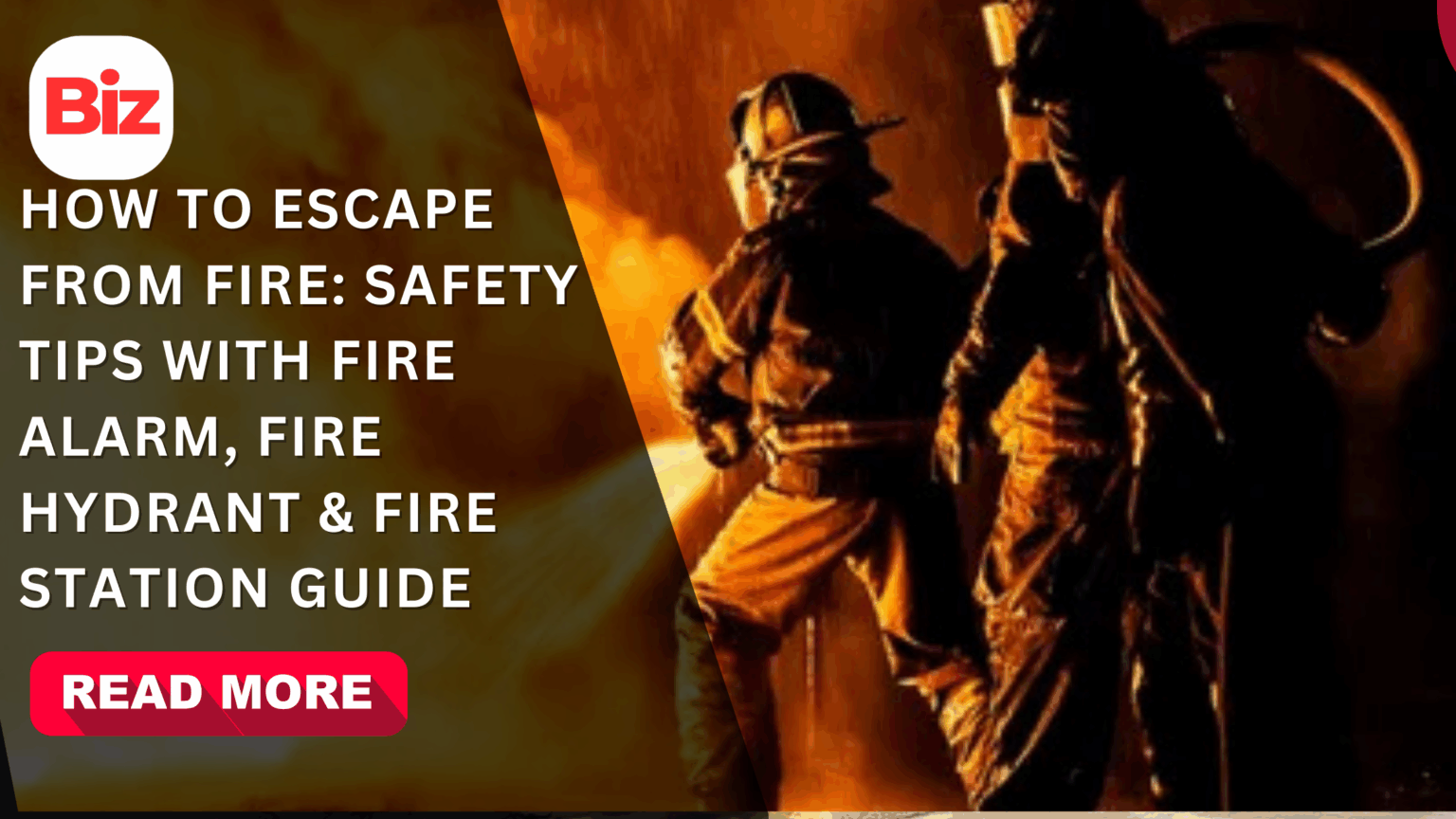- Why preparation matters
- What to do in the event of a fire.
- How to scape:
- How to scape from High-rise buildings
- The interaction between the firefighters, the fire station and the hydrant.
- The importance of fire alarm and fire alarm system in life saving.
- What to preach to children and housemates.
- Extra conditions and precautions.
- Tools to have and maintain
- Local efforts that contribute to making all people survive the fires.
- A follow up after the escape.
Fire is quick, noisy and scary, however, the correct information and a clear mind will give you the best opportunity to escape unharmed. This blog takes you through easy straight forward steps that can allow you to get out of a fire at home or at work or in a building that houses people. On the way we will describe how such tools and services as the fire alarm, the fire alarm system, the fire hydrant and the fire station all contribute to an effective escape. Read it once, and have a brief checklist to hand, and make the main steps your business, so that they become near automatic.
Why preparation matters
The majority of those who survive fire construction do not do it because they were lucky, but because they were prepared to survive. Preparation means:
- Being aware of ways out.
- A good fire alarm or a complete fire alarm system (having working detection).
- Drilling an evacuation plan.
- Knowing what to do when you can not escape due to smoke or fire.
- Being aware of emergency assistance (where is the fire station / dial emergency services) and the way in which firefighters apply certain tools, such as fire hydrant.
- One minute will be a big difference in a fire. The smoke travels further than the flames, and most death is caused by inhalation. It will calm you down and give you time to operate.
What to do in the event of a fire.
Call attention to others–Say loudly: Fire! to call on household members and awake neighbors. Sound the closest fire alarm in the building, in case it has one. One calling loudly will not be heard by everybody; an alarm system triples your signal.
Turn the fire alarm on — In a building equipped with a centralized fire alarm system, pull the manual alarm unless it is close. There is also a lot of systems that will automatically activate the local fire station dispatching firefighters. Do not suppose that it has been pulled by someone.
Call an ambulance – Assuming it is not dangerous, call your local emergency number immediately. Provide a descriptive address and the floor/location of fire. When you can not get through, keep on alerting people and attempt to get out. The faster the fire station can be deployed, the faster a crew and a water supply (with the help of fire hydrant) will get there.
Get in a hurry: only trained to fight small fire Use only when extinguisher available and know how to use it (PASS: Pull, Aim, Squeeze, Sweep) If the blaze is small (as big as a wastebasket) and you have an extinguisher and know how to use it, you might decide to put the fire out. If not 100% confident, evacuate.
How to scape:
Stay low and move fast
Smoke rises. The air will be less sense-choked in the air near the floor. On your hands and knees move with your head 12-24 inches above the floor when there is smoke. Hurry as much as you can, smoke and heat obscure vision and create hazards within a short period of time.
Know your exits
Prior to the case of an emergency, find at least two exits of every room: a door and a window, or two doors. In high-rise properties, the main exit is the stairways — never take an elevator during fire. Lifts may malfunction, entrap or burst on a burning floor.
Check doors before opening
Touch the door, doorknob and frame with the back of your hand: if hot, do not open it. In case it is cold open the door ajar and stand at the ready in case you see or smell smoke or fire in the other room.
Close doors behind you
Sealing doors will aid in the containment of a fire and slow the spread of smoke, which will purchase time on your part and rescuers. close the door when you have to leave a room.
Last resort escape by use of window.
In case your main exits are blocked and you are on a storey higher than the ground floor, remain there and call upon rescue unless you can leave in a safe manner. When you have to leave the building by a window on a lower floor, look to see whether you can safely land; otherwise see whether you can lower yourself gradually, and have some one help you. You should not jump out of high windows unless it is a last chance.
If trapped, seal the room
Should you be unable to leave, block cracks about doors with bedding or towels to keep out the smoke. Communication through flashlight or bright cloth, and call emergency services and explain where exactly you are. Note: to be rescued, the fire station should have a clear and accurate information.
Stop, Drop, and Roll
When clothing is on fire, cease at once, get on the ground, put your face down, and roll up and roll over until the fire has been extinguished. This is a very easy method of saving lives. Then, cool down with running water and obtain medical attention.
How to scape from High-rise buildings
The high-rise buildings depend on the systems designed (sprinklers, fire alarm systems, smoke control). Additional tips:
- Be familiar with where the stairwells are and evacuation plan of the building.
- Get to know how the building has fire alarm system in place- whether they automatically notify the fire station or just alert the occupants?
- When the alarm goes off, go as quickly as you can unless you are sure it is a false alarm. Fire propagates quickly in the vertical shafts and thus, remaining at the same position is not often safe unless instructed by the firefighters.
- Do not use the elevator, use the stairwell.
- Firefighters can be equipped on higher levels with external water (either a fire hydrant) and hoses to address the fire; easy access of stairwells and exterior doors promotes their work.
The interaction between the firefighters, the fire station and the hydrant.
When the fire has been reported, the closest fire station deploys units. Firefighters also come equipped with water tankers and hose, but they usually use the water supplies of the people via fire hydrants to provide continuous supply of water to a bigger fire. The lifeblood is the fire hydrant – it provides high end water to the hose lines. A functioning fire alarm system is quicker at detecting and responding in the interior of the buildings and hydrants can be used in the exterior to suppress.
What you might be doing to assist the responders:
- Always include address and floor when calling.
- Open gates and clear driveways to help fire trucks to access the building.
- Clear hydrants and obstructions of vehicles – the fire crews are to have an easy access to the nearest fire hydrant.
- Do as instructed when fire station staff arrives, they will direct you where to meet and also tell you whether to evacuate or provide shelter is safe.
The importance of fire alarm and fire alarm system in life saving.
The simplest type of fire alarm is a warning device that notifies citizens of smoke or warmth in a room or area. A whole-building fire alarm system is a combination of various detectors, manual pulls and notification devices (sirens, strobes). New systems can automatically alert the fire station or a monitoring service that subsequently makes phone calls to firefighters.
- Place smoke detectors on all floors and the exits of sleeping places.
- Check test alarms at least once monthly and change batteries at least once per year (or when the alarm chirps).
- Change smoke detectors after every 10 years.
- In the case you are in a building with a fire alarm system, know how it works: various sounds or strobes can have various meanings (evacuate vs. alert). When in doubt, evacuate.
What to preach to children and housemates.
Children and housemates need to know:
- The way to identify the sound of the fire alarm.
- The family escape plan which had two ways out of each room.
- An outside meeting spot (e.g. the yard of a neighbor, a tree) where all will be counted.
- How to dial an ambulance and give the address.
- Not to conceal themselves in a fire–to get out and keep out.
- Conduct fire drills on a bi-annual basis (and at night). Familiarity reduces panic.
Extra conditions and precautions.
In case you are living with mobility difficulties.
Be prepared and plan with the building management and the fire station just in case you need help. Find refuges (stairwell landings that are fire-resistant) and make sure that first responders are acquainted with your residence. Numerous contemporary buildings are equipped with evacuation chairs and personnel who are trained to help.
In case you are in a car and a fire breaks out along the road.
Stay away as far as possible. Call the ambulance and evacuate the smoky places. Should be safe, park out of the road to allow emergency vehicles to pass in the direction of the fire station.
If smoke is thick in a hallway
It is important to remain close to the floor. Go swiftly and take caution to the closest exit. In case you are not able to escape, enter a room with an opening to the outside, shut the door and close up. Send out an SOS and call an ambulance with an explanation of your position.
If sprinklers activate
Sprinklers rescue life and propagation of fire; in case sprinklers are discharged flee on the spot. They are meant to absorb the fire heat and not to drown a building.
Tools to have and maintain
- Smoke detectors on each floor and bedrooms. Test monthly.
- Emergency smoke detector on fire should your building have one– make sure that it is maintained as per local code.
- Fire extinguishers on every floor particularly in areas around kitchens. Know how to use them (PASS).
- Each bed had a flashlight and a whistle to use and attract rescuers.
- A plain ladder to get out of the window of the upper floors (unless you are on the ground floor).
- Emergency contact sheet with local fire station and emergency service telephone number.
Local efforts that contribute to making all people survive the fires.
- Always keep access routes and fire lanes clear so that trucks may access hydrants and fire station respond instantly.
- Don’t park near fire hydrants. In most locations, it is an offense and poses as an obstacle to water access.
- Join local fire station community fire safety programs, your local fire station may have home inspection and advice programs.
- Professionally urge landlords and managers of buildings to keep working fire alarm systems and sprinkler systems.
A follow up after the escape.
- Do not go into a burning house. Wait for the professionals. A little outburst will ensnare you.
- Report to your rendezvous point so that you can be called to account and rescuers can be aware of those who might still be trapped in.
- Instruct firefighters whether any are missing and their last whereabouts.
- Seek medical treatment of burns or smoke inhalation, despite what might seem like the tiniest of injuries and burns- the injury may manifest itself later.
- Your local fire department or fire station should be contacted in case of damaged home and they can provide you with information on when it is safe to get back and on local resources.
- Damage insurance documents, however, when it is safe and you are permitted to gain access by the authorities.
ALSO READ Top 10 Hospitals in Dubai 2025 | Best Hospitals & Healthcare Guide








